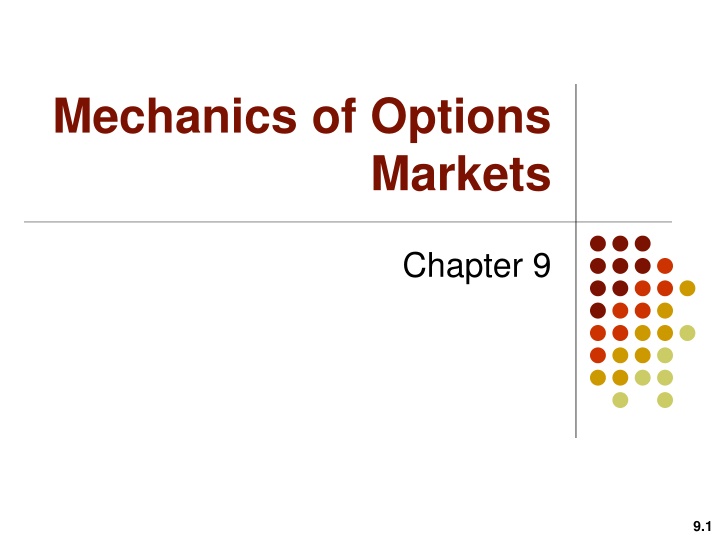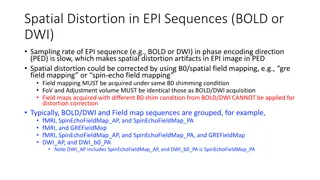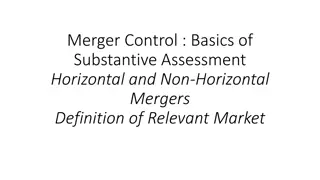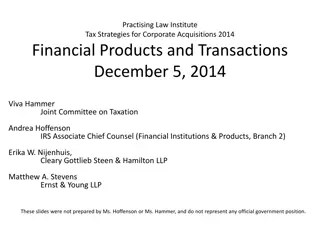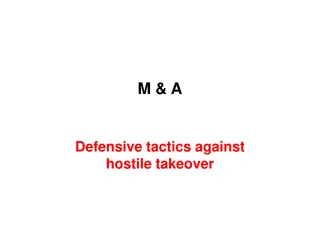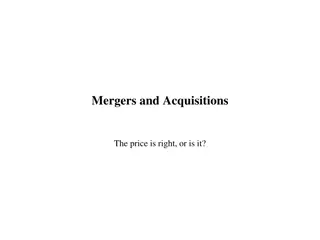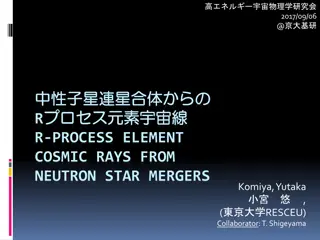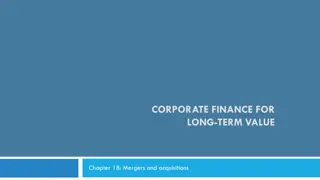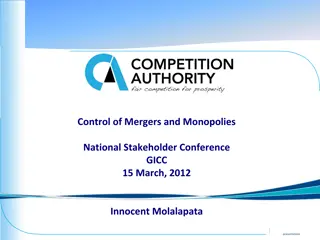Mergers & Acquisitions Overview
Mergers and Acquisitions (M&A) involve transactions where companies combine or one acquires another for strategic growth. Learn about different M&A types, forms of acquisition, and the valuation process.
Download Presentation

Please find below an Image/Link to download the presentation.
The content on the website is provided AS IS for your information and personal use only. It may not be sold, licensed, or shared on other websites without obtaining consent from the author.If you encounter any issues during the download, it is possible that the publisher has removed the file from their server.
You are allowed to download the files provided on this website for personal or commercial use, subject to the condition that they are used lawfully. All files are the property of their respective owners.
The content on the website is provided AS IS for your information and personal use only. It may not be sold, licensed, or shared on other websites without obtaining consent from the author.
E N D
Presentation Transcript
Mechanics of Options Markets Chapter 9 9.1
Goals of Chapter 9 Introduce different types of options Including call and put options, European vs. American options, and options with different underlying assets Items in the contracts of stock options Details of trading options on exchanges Introduce three option-like instruments Warrants ( ), employee stock options ( ), and convertible bonds ( ) 9.2
9.1 Different Types of Options 9.3
Types of Options Two basic types of options A call ( ) (put ( )) option gives option holders the right to buy (sell) an asset at a certain price by a certain date The date specified in the contract is known as the expiration dateor the maturity date ( ) The price specified in the contract is known as the exercise price or the strike price ( ) European vs. American options A European ( ) option can be exercised only at the end of its life, i.e., on the maturity date American ( ) options can be exercised at any time9.4
Types of Options Options vs. Forward and Futures 1. An option gives holders the right to do something, but holders do not have to exercise this right In forwards or futures, the two parties have committed themselves to do some action in the future 2. Purchase of an option requires an up-front payment Forwards or futures cost a trader nothing (except for the margin requirements) when they are initiated Special assumption in this text book Time value of money of the option price is not considered to calculate the option profit, which equals the final payoff (received at the end of the option life) minus the option price (paid at the beginning of the option life) 9.5
Option Positions Four positions for option traders Long call Long put Short call Short put The term of long means to buy options, and the term of short means to sell or issue (or write) ( ) options The holder of an option pay the up front cost to acquire the option with a right to do something in the future The writer of an option receives cash up front but has potential liabilities in the future 9.6
Profit of Longing a Call Profit at maturity for buying one European call option: option price = $5, strike price = $100, option life = 4 months Profit ($) 30 20 10 Terminal stock price ?? ($) 70 80 90 100 0 45 110 120 130 5 Note that as long as ?? is higher (lower) than the strike price, the call holder should (should not) exercise this option Since the cost to acquire the call option is $5, the call holder earn a positive profit when ??is higher than (strike price + $5) 9.7
Profit of Shorting a Call Profit from writing the same European call option: option price = $5, strike price = $100, option life = 4 months Profit ($) 120 130 110 5 45 0 70 80 90 100 Terminal stock price ?? ($) 10 20 30 When ?? is lower than the strike price, the call holder gives up his right and thus the option writer can earn the whole $5 of option price If this call is exercised, the maximum losses of the call writer are unlimited The call writer s profit or loss is the negative of that for the call holder 9.8
Profit of Longing a Put Profit from buying a European put option: option price = $7, strike price = $70, option life = 3 months Profit ($) 30 20 10 Terminal stock price ?? ($) 0 40 50 60 70 80 90 100 45 7 Note that as long as ?? is lower (higher) than the strike price, the put holder should (should not) exercise this option Since the cost to acquire the put option is $7, the put holder earn a positive profit when ??is lower than (strike price $7) 9.9
Profit of Shorting a Put Profit from writing the same European put option: option price = $7, strike price = $70, option life = 3 months Profit ($) Terminal 7 40 50 60 45 stock price ?? ($) 0 70 80 90 100 10 20 30 The put writer s profit or loss is the negative of that for the put holder The put writer s profit declines when the stock price falls below the strike price ($70), and the breakeven point for the put writer is $63 (=$70 $7) 9.10
Payoff Functions of European Options Payoff is the final payment at maturity. The deduction of the option price is not necessary Payoff of longing a call Payoff of longing a put ST ST K K Note the opposite relationship between the payoff functions of longing and shorting options max(?? ?,0) max(? ??,0) Payoff of shorting a call Payoff of shorting a put K K ST ST max(?? ?,0) max(? ??,0) 9.11
Types of Options Several exchange-traded options Stock options ( ) Most stock options are traded on exchanges In the U.S., one stock options gives the holder the right to buy or sell 100 shares of stock at the specified strike price In the U.S., exchange-traded stock options are American- style options ETF options ( ) ETFs (Exchange-Traded Funds) are listed on an exchange and traded like a share of company s stock ETFs are designed to track an equity or bond index and provide traders with the return they would earn as if they invested in the component assets that constitute the index ETF options are traded like stock options, which are American style and settle for shares of the underlying ETF9.12
Types of Options Index options ( ) The most popular exchange-traded option contracts in the U.S. are the index options on S&P 500 index, S&P100 index, NASDAQ-100 index, and Dow Jones Industrial Average Index All of the above are traded on Chicago Board Options Exchange (CBOE) Most index options are European An exception is the index option on S&P 100 index Cash settlement One index option contract is to buy or sell, for example 50, times the index at the specified strike price Consider a call option with a strike price of 980, which is exercised when the index value is 992. The option writer pays the option holder max(992 980,0) $50 = $600 9.13
Types of Options Foreign currency options ( ) Most currency options trading occurs in OTC markets, but there is some exchange trading In the U.S., NASDAQ OMX offers European-style option contracts on a variety of different currencies One option contract is for trading 10,000 units of a foreign currency (for 1,000,000 units of Japanese yen) Futures options ( ) The underlying asset of a futures option is a futures contract with a longer time to maturity When an exchange trades a particular futures contract, it often also trades (American) options on that futures contract 9.14
Types of Options Notations: the strike price is ?, the maturity date for the futures option is ?, the maturity date for the underlying futures is ?1 (> ?), and the futures price at ? is ?? Call futures option: when ??> ?, the holder exercises his right and receive a long position in the underlying futures contract plus a cash amount equal to (?? ?) Put futures option: when ??< ?, the holder exercises his right and receive a short position in the underlying futures contract plus a cash amount equal to (? ??) Note that the futures contract received by the option holder at ? is worth zero because the zero-value futures is always the case when it is initiated If option holders close out the futures position immediately by entering into an offsetting position, they can finish the transaction completely and earn the received cash amount9.15
Types of Options Reasons to trade options on futures rather than options on a underlying commodity asset 1. A futures contract is more liquid than its underlying asset due to different types of market participants 2. Futures option is settled in cash plus a futures position rather than settled by physical delivering In contrast, options on commodity assets often need physical delivering Since the futures contract can be closed out prior to the delivery date, it can avoid concerning delivery options and delivery costs for physical delivering If the futures contract is held to the delivery date, traders still can employ it to trade the underlying commodity asset physically at the price of ?? 3. To make futures options more competitive, futures options often entail lower transaction costs than options on commodity assets9.16
9.2 Trading Options on Exchanges 9.17
Trading Options on Exchanges Standard stock options in the U.S. are employed to explain option trading on exchanges Items in option contracts European or American In Taiwan, both index and stock options are European style, but warrants (introduced later) are American style Expiration date (or maturity date) ( ) Expiration date: the third Friday of the expiration month Trading takes places every business day (8:30 a.m. to 3:00 p.m. Central time) until the expiration date Long-term equity anticipation securities (LEAPs) trade on many stocks with the time to maturity up to 39 months and the expiration date to be the third Friday of January 9.18
Trading Options on Exchanges Stock options are issued on the Jan., Feb., or Mar. cycle The Jan. cycle months consists of Jan., Apr., July, and Oct. (similar for Feb. and Mar. cycles) The following two rules determine listing options with different maturity months at any time during a year 1. If the expiration date in the current month has not yet been reached, options trade for the current month (until the expiration date), the following month, and the next two months in the cycle 2. If the expiration date in the current month has passed, options trade for the next month, the next-but-one month, and the next two months in the cycle (When one option expires, trading in another month option is started such that the above two rules can be satisfied) Exchanges can use their own rules for listing options with different maturity months, e.g., maybe the next three cycle months are considered 9.19
Trading Options on Exchanges Strike price For each maturity, there is a series of strike prices spaced $2.5 (for stock prices between $5 and $25), $5 (for stock prices between $25 and $200), or $10 (for stock prices above $200) apart When options with a new expiration month debuts ( ), the two or three strike prices closest to the current stock price are selected as the strike prices for the options If the stock price moves outside the range, a new strike price is introduced to extend the range to cover the stock price Suppose the stock price is $82, the initial strike prices for options may be $80, $85, $90. If the stock price rises above $90 (declines below $80), the option with the strike price of $95 ($75) is initiated 9.20
Trading Options on Exchanges Some terminologies Intrinsic value ( ) vs. Time value ( ) Option value = Time value + Intrinsic value The intrinsic value of an option is defined as the payoff of the option if it were exercised immediately For calls, the intrinsic value is max ?? ?,0 For puts, the intrinsic value is max ? ??,0 An American-style option is worth at least as much as its intrinsic value because the option holder always can realize the intrinsic value by exercising the option immediately Example: If the current stock price ?? is $110 and the strike price ? is $100, a call is worth $12, which can be decomposed as $2 (time value) and $(110 100) = $10 (intrinsic value) 9.21
Trading Options on Exchanges Moneyness ( ) In the money (ITM) ( ): Options are referred to as in the money if they have positive intrinsic values, i.e., ??> ? for calls and ??< ? for puts Out of the money (OTM) ( ): Options are referred to as out of the money if they have zero intrinsic value, i.e., ??< ? for calls and ??> ? for puts At the money (ATM) ( ): ??= ? for both calls and puts An ITM option will always be exercised on the expiration date (?), i.e., if ??> ? for calls or ??< ? for puts, those options will always be exercised 9.22
Trading Options on Exchanges Anti-dilution provisions ( ) Adjustment for cash dividends Some OTC options are cash dividend protected If a company declares a cash dividend, the strike price for calls (puts) on the company s stock decreases (increases) on the ex- dividend day ( ) by the cash dividend amount Most exchange-traded options in the U.S. are not adjusted in response to cash dividends, which therefore reduce (increase) values of call (put) options Exchange-traded options are adjusted for stock split or stock dividends An?-for-? stock split is to use ? newly-issued stock shares to exchange for ? outstanding stock shares A 20% stock dividend is equivalent to a 6-for-5 stock split because shareholders receive 0.2 additional shares for each 1 share owned 9.23
Trading Options on Exchanges The effect of stock split and paying stock dividends is to issue more shares to replace existing shares, so there is no impact on the asset value or the earning ability of a company An ?-for-? stock split or stock dividends theoretically cause the stock price to go downward to ?/? of its previous value Two items in option contracts are adjusted to offset expected changes in a stock price arising from a stock split or a payment of stock dividends The strike price is reduced to ?/? of its previous value The number of shares covered by one options is increased to ?/? of its previous value In Taiwan, both warrants and stock options traded on exchanges have provisions of cash-dividend protection Index options may be still stock-dividend (-split) protected, although there is no explicit clauses of adjustments for stock splits and stock dividends in index option contracts As long as the index level does not change after stock splits and distributions of stock dividends, e.g., Taiwan weighted index or S&P 5009.24
Trading Options on Exchanges Consider a call option to buy 100 shares for the strike price to be $20/share How should terms be adjusted: For a 2-for-1 stock split? The strike price is reduced to $10 (=$20 (1/2)) The number of shares covered by one options is 200 (=100 2) For a 25% stock dividend? It is equivalent to a 5-for-4 stock split The strike price is reduced to $16 (=$20 (4/5)) The number of shares covered by one options is 125 (=100 (5/4)) 9.25
Trading Options on Exchanges Position and exercise limits A position (exercise) limit defines the maximum number of option contracts that an investor can hold (exercise) on one side of the market Prevent from being unduly influenced by one investor Long calls and short puts are treated to be on the same side of the market (bull s view) Short calls and long puts are treated to be on the same side of the market (bear s view) The exercise limit usually equals the position limit Determined by the number of understanding shares and trading volume associated with each underlying stock For the largest and most frequently traded underlying stocks, the position limit can be 250,000 contracts on CBOE 9.26
Trading Options on Exchanges Commissions ( ): charged by a broker and calculated as a fix cost plus a proportion of the dollar amount of the trade of options The commission is charged both when an option position is initiated and when it is closed out by an offsetting trade For retail traders, a commission schedule is Dollar amount of trade Commission $20 + 0.02 of dollar amount < $2,500 $2,500 to $10,000 > $10,000 $45 + 0.01 of dollar amount $120 + 0.0025 of dollar amount Maximum (minimum) commission is $30 per contracts for the first 5 contracts plus $20 ($2) for each additional contract 9.27
Trading Options on Exchanges Note that if the option is exercised, the option holders need to pay the commission for trading the underlying shares, which is a proportion, e.g., 1.5%, of the trade amount on the underlying shares The commissions for trading options vary significantly for different brokers and exchanges For Taifex, the commissions for trading futures and options can refer to https://www.taifex.com.tw/cht/4/feeSchedules 9.28
Trading Options on Exchanges Most exchanges use market makers ( ) to facilitate options trading Since so many option contracts are concurrently traded on exchanges, some of them are with thin trading volume Market makers enhance the liquidity by always being ready to trade options with other traders Market makers quote both bid and ask (offer) prices The bid (ask) is the price at which the market maker is prepared to buy (sell) the options The ask is always higher than the bid, and the bid-ask spread is the source of the profit for market makers The bid-ask spread is a hidden cost for option traders 9.29
Trading Options on Exchanges Margins ( ) In the U.S., when stock shares are purchased, a trader can either pay cash or borrow using a margin account (this is known as buying on margin) In contrast, for option buyers, buying on margin is not always allowed For options with times to maturity less than 9 months, the option price must be paid in full For options with times to maturity longer than 9 months, investors can buy on margin, borrowing up to 25% of the option price (Options already contain substantial leverage effect (see Slide 1.30), so it is improper to further raise leverage level with buying on margin) 9.30
Trading Options on Exchanges For option writers, it is required to maintain funds in a margin account to minimize their default risk The required margin amount for writing a naked optionis the greater of the following two quantities: 1. A total of 100% of the proceeds of the sale plus 20% of the underlying share price less the amount (if any) by which the option is out of the money 2. A total of 100% of the proceeds of the sale plus 10% of the underlying share price for calls (10% of the strike price for puts) A naked option is an option that is not combined with an offsetting position in the underlying asset initially (an example of a non-naked option is shown on the next slide) The above is the margin requirement imposed by the OCC to its members (Slide 9.33 will discuss OCC and its members) A brokerage house may require a higher (but no less) margin than the above from its clients 9.31
Trading Options on Exchanges The above calculation are performed everyday (but with the prevailing prices of options and the underlying asset instead) to determine daily required margins For index options, the 20% is replaced by 15% because a stock index is usually less volatile than the price of an individual stock For other trading strategies, such as covered calls, protective puts, spreads, combinations, straddles, and strangles, the CBOE defines special rules for determining the margin requirements (Option trading strategies will be discussed in Ch. 11) For example, a covered call is a written call option when the shares that might have to be delivered are already owned by the call writer Therefore, the worst scenario for the writer of a covered call is to sell the shares he owns at the strike price when the call is exercised by the call holder Since the default risk of the writer of covered calls is minor, there is no margin requirements for writing covered calls 9.32
Trading Options on Exchanges The Options Clearing Corporation ( , OCC) The OCC plays the same role in option markets as the clearing house does in futures market (see Ch. 2) Funds to purchase an option must be deposited with the OCC by the morning of the business day following the trade The OCC records all long and short positions The OCC has a number of members, and all options trades must be cleared through its members Hierarchy of the required margin for writing options: Option writers maintains a margin account with a broker The broker maintains a margin account with a OCC member The OCC member maintains a margin account with the OCC9.33
Trading Options on Exchanges Clearing process of exercising options: When a trader notifies a broker to exercise an option, the broker in turn notifies the OCC member which will place an exercise order with the OCC The OCC randomly selects a member with an outstanding short position in the same option, and that member selects a particular trader who has written the option according to some pre-specified rules In the U.S., the Commodity Futures Trading Commission is responsible for regulating markets for options or futures 9.34
Trading Options on Exchanges Taxation issues for options 1. When the option position is closed out or expires unexercised The gains and losses from the trading of stock options are taxed as capital gains or losses 2. When the option is exercised The gain or loss from the option is rolled into the position taken in the stock and recognized when the stock position is closed out For the holder who exercises a call (For the call writer), he can acquire a long (short) position in the underlying stock at the strike price plus the call price For the holder who exercises a put (For the put writer), he can acquire a short (long) position in the underlying stock and the net income (cost) equals the strike price less the put price 9.35
Trading Options in OTC Market Trading options in OTC markets The OTC market for options has become increasingly important since the early 1980s and is now larger than the exchange-traded market OTC options on foreign exchange and interest rates are particularly popular The advantage of OTC options is that they can be custom-made to meet the precise needs of investors The disadvantage of OTC options is that option writer may default To overcome this disadvantage, option writers are sometimes required to post collateral 9.36
9.3 Warrants, Employee Stock Options, and Convertible Bonds 9.37
Warrants, ESOs, and CBs Warrants, employee stock options (ESOs), and convertible bonds (CBs) are option-like instruments Warrant ( ): Warrants are options issued by financial institutions or nonfinancial corporations The warrant issuer settles up with the warrant holder when a warrant is exercised A financial institution might issue put warrants ( ) on gold and then to proceed to create a market (by offering bid and ask prices) for trading these warrants The warrants issued by financial institutions can be traded on an exchange or in an OTC market, and the issuing financial institution acts as the market maker for this warrant9.38
Warrants, ESOs, and CBs A common use of warrants by a nonfinancial corporation is to issue call warrants ( ) on its own stock and attaches them to the bond issue To make the corporate bond more attractive to investors To reduce the coupon rate of the corporate bond and thus save the funding cost Employee stock option (ESO) ( ): ESOs are call options issued to employees by their company to align the interests between the employees and the shareholders Usually are issued to be at the money at issuance If the performance of the company is improved and thus the share price rises, the ESO becomes in the money and brings profit for employees 9.39
Warrants, ESOs, and CBs ESOs cannot be exercised within a period of time (usually 1 to 4 years) ESOs cannot be sold to others ESOs can last for as long as 10 or 15 years Today, ESOs are recorded as expenses at their fair market in the company s income statement in most nations (rather than recorded as the distribution of the stock dividends in the balance sheet in the past) This accounting principle makes ESOs a less attractive form of compensation than they used to be Classified as the expense: affect the income statement as well as the net worth the of firm on the balance sheet Classified as the stock dividends: affect the number of outstanding shares and the net worth per share of the firm on the balance sheet (it does not affect the net worth of the firm) 9.40
Warrants, ESOs, and CBs Convertible bond (CB) ( ) CBs are bonds issued by a company that can be converted into equity at certain time points using a predetermined conversion ratio A CB is a hybrid security of bond and equity Note that CBs are different from bonds with an attached call warrant on the company s stock This is because you cannot separate the conversion right clearly from a CB Very often a convertible is callable ( ) The call-back provision is a way in which the issuer can force the conversion at a time point earlier than the holder might otherwise choose CB holders can choose to exercise the conversion right after receiving the call back notification 9.41
Warrants, ESOs, and CBs Different from the options traded on exchanges, the numbers of outstanding warrants, ESOs, and CBs are predetermined on the issue day The numbers of outstanding warrants, ESOs, and CBs are determined by the size of the original issue and decrease when they are exercised or when they expire In contrast, as more people trade a particular option contract on an exchange, the number of outstanding exchanged- traded options increases 9.42
Warrants, ESOs, and CBs When these three instruments are exercised, the company issues more shares of its own stock and sells the stock shares to the option holder for the strike (or conversion) price Thus, the exercise of these three instruments leads to an increase in the number of outstanding shares of the issuing company Note that the above statement is not true for warrants issued by financial institutions As warrant writers, financial institutions need to buy or sell underlying assets from markets for settlement 9.43
